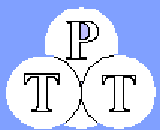
| Spis treści |
Biuletyn
Polskiego Towarzystwa Tribologicznego
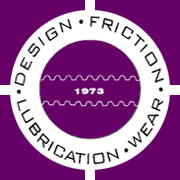
Member of the International Tribology Council

Publikacja dofinasowana przez Komitet Badań Naukowych
 |
Biuletyn
|
Szanowni Koledzy
Każda Organizacja w tym i PTT, aby mogła funkcjonować musi mieć zebrane składki od swoich członków. W naszej działalności zaniedbaliśmy trochę ten problem i z tego tytułu mieliśmy na końcu ubiegłego roku trudności w wypłaceniu niektórych należności.
Nasz adres:
Serdecznie Wszystkich Naszych Członków pozdrawiam. Stanisław PYTKO-prezes |
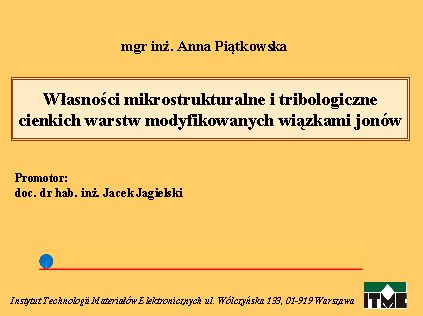
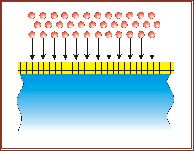
|
dr hab. Władysław Skoneczny ROZPRAWA HABILITACYJNA | |
| Temat: | Kształtowanie właściwości warstw wierzchnich aluminium i jego stopów metodą anodowania twardego. |
|
AKADEMIA TECHNICZNO-HUMANISTYCZNA w Bielsku-Białej Wydział Budowy Maszyn i Informatyki
Data wszczęcia przewodu: 9 listopad 2001 r. 16 grudnia 2002 r. Centralna Komisja do Spraw Tytułu Naukowego i Stopni Naukowych Zatwierdziła uchwałę Rady Wydziału.
Recenzenci: Prof. zw. dr hab. inż. Stanisław Pytko.
Dyscyplina: Budowa i Eksploatacja Maszyn. Streszczenie
| |
VI Konferencja
PROBLEMY NIEKONWENCJONALNYCH UKŁADÓW ŁOŻYSKOWYCH
MIEJSCE I TERMIN KONFERENCJI
Konferencja odbędzie się w Niedzicy, w dniach 16-19 września 2003r.
TEMATYKA KONFERENCJI
KORESPONDENCJE:
15.02.2003 Termin nadsyłania zgłoszenia wstępnego i streszczenia referatów (maksymalnie jedna strona formatu A4). Adres e-mail.
28.02.2003 Drugi komunikat powiadamiający o przyjęciu referatu, wytyczne do opracowania referatu.
23.05.2003 Termin nadsyłania pełnego tekstu referatu. Referaty mogą być napisane w języku polskim lub angielskim. W przypadku opracowania tekstu w języku angielskim niezbędne jest dołączenie obszernego streszczenia w języku polskim. Referaty opracowane w języku polskim powinny zawierać streszczenia w języku angielskim i rosyjskim. Przewiduje się drukowanie nadesłanych referatów w Materiałach Konferencyjnych, Tribologii, Zeszytach Naukowych Politechniki Łódzkiej i kwartalniku ZEM.
20.06.2003 Ostateczny termin nadsyłania poprawionego tekstu referatu.
16.09.2003 XXVI Szkoła Tribologiczna
OPŁATY:
Koszt uczestnictwa wynosi:
wpłata do 17 maja
- 1100 zł. - pełny koszt uczestnictwa
- 900 zł. - koszt uczestnictwa dla studentów i emerytowanych pracowników naukowo-dydaktycznych
wpłata po 17 maja
- 1300 zł. - pełny koszt uczestnictwa
- 1000 zł. - koszt uczestnictwa dla studentów i emerytowanych pracowników naukowo-dydaktycznych
20.06.2003 Nieprzekraczalny termin nadsyłania opłat za uczestnictwo w konferencji.
ADRES BIURA KOMITETU ORGANIZACYJNEGO
Zakład Geometrii Wykreślnej i Rysunku Technicznego
Instytutu Konstrukcji Maszyn Politechniki Łódzkiej
ul. B. Stefanowskiego 1/15
90-924 Łódź
tel. (042) 631 22 49
fax (042) 631 22 52
e-mail: zgwirt@mail.p.lodz.pl
Komitet Honorowy Konferencji:
Komitet Organizacyjny Konferencji:
Komitet Naukowy Konferencji:
|
1. 2002 Tribology Gold Laureate Professor N A Bushe, one of the world's highly regarded tribologists, is the Tribology Gold Medal Winner for 2002. See his citation. On behalf of all members, the ITC extends its warm congratulations to Professor Bushe on this well merited award. The presentation of the Medal and the accompanying Parchment is expected to take place by the British Ambassador to Russia at a date yet to be announced.
2. Honour for Tribology Gold Medallist Professor Wilfried Bartz, Tribology Gold Laureate, has been awarded an Honorary Doctorate of Science by the V A Belyi Metal Polymer Research Institute of Belarus, National Academy of Sciences in Gomel. The International Tribology Council extends its congratulations to Professor Bartz on this further recognition of his work on behalf of Tribology.
3. Promotion for Vice President of Society of Tribologists of Belarus Prof. Nikolai Myshkin, Chairman of the Society of Tribologists of Belarus has been promoted to be Head of the VA Belyi Metal Polymer Research Institute of the Belarus National Academy of Sciences. The Institute has a total staff of 400 has the largest tribology research team in the former Soviet Union, it is also a publisher of the Friction and Wear Journal (English translation by Allerton Press, NY). Professor Yuri Pleskachevsky, Professor Myshkin's predecessor has been elected a Vice President of the Belarus National Academy of Sciences.
4. Award for Vice President of SAIT Professor Philip L de Vaal of the University of Pretoria and ITC Vice President received the Wilbur Deutsch Memorial Award from STLE for his paper on the practical aspects of lubrication.
5. Award for Slovenian President The President of the Slovenian Society for Tribology, Professor Joze Vizintin has been awarded with the highest Slovenian award for scientific work - ZOIS Award for outstanding scientific achievements in the field of mechanical engineering.
6. Awards at NORDTRIB Conference During 2002 the NORDTRIB conference was held in Stockholm. During the conference dinner, which was held at the Royal Swedish Academy of Engineering Sciences, Professor Koji Kato, Sendai, was give the Diploma as a Foreign Member of the Academy, and Professor Erik Hoglund, Lulea, was give the Diploma for become a Swedish Member of the Academy. Both are tribologists and Erik Hoglund now had the Chair that Gold Medallist Bo Jacobson occupied from 1973 to 1987.
7. Japanese Society of Tribologists The following changes have been announced by the Japanese Society of Tribologists:
The official address of the Society is now: The present Vice President, Professor M Nishimura has been succeeded by Professor Masato Tanaka.
8. Bulgarian Tribology Society At the Annual Meeting of the Society of the Bulgarian Tribologists a new Managing Board was elected. The position of President of the Society of the Bulgarian Tribologists was conferred on Assoc. Prof. Dr. Emila Assenova.
9. Change in French Tribology Society The official name of the French Society is: Association Francaise de Mecanique - Group Scientifique et Techique "Tribologie" and its address is: Maison de la Mecanique, 92038 Paris La Defense, France. Monsieur Michel Armbruster who has been associated with ITC for many years since it foundation, has retired as President and has been elected to the "Association des Professionels et Amis e L'Aeronautique et de L'Espace". ITC thanks M. Armbruster for his support and services rendered to ITC over many years and wishes him well for his future. The new Tribology Group President is Tribology Gold Medallist Professor Jean Frene. His address is: Faculte des Sciences, Laboratoire de Mecanique des Solides, SP2M1 - Bd 3 - Teleport 2 - BP 179, 86960 Futuroscope Cedex, France. A new ITC Vice President will be nominated by Professor Frene in due course. M. Phillipe Durouchoux who will shortly retire, will be replaced as ITC Corresponding Member by M. Pierre-Alain Hacq, Delegue General, Association Francaise de Mecanique.
10. Tribology Creates New Links between US and China STLE joined with its counterpart organisation in China during October to co-sponsor a successful technical conference and to explore a working relationship between the two groups on future co-operative projects. The joint conference, built around the theme "New Frontiers in Tribology" was held October 17-19 at Tsinghua University in Beijing and was organised in co-operation with the Chinese Tribology Institute (CTI). The conference met its objectives of establishing a working relationship between the two societies, producing a high quality technical program and acquainting STLE with the capabilities of the Tribology Department at the University. Attendance at its maximum was about 76 people. Of these, 58 were professional people, and the remainder (about 20%) were students and graduates from the university. The conference technical program explored how tribologists and lubrication engineers in China and US are putting their technical expertise to work assisting global OEMs and fuel and lubricant additives manufacturers who are attempting to meet the challenges of changing consumer needs, environmental requirements and energy conservation. Future areas of co-operation between CTI and STLE ay include additional technical conferences, translation of technical information and interaction between the technical committees of each organisation.
11. Report from IRG OECD Meeting The Tribology Society of Finland celebrated its 25th Anniversary on the 15th November 2002 in Helsinki. The meeting was chaired by Professor Arto Lehtovaara, the President of the Society and it was attended by its Honorary President Professor Kauko Aho, several precious Society Presidents and numerous members of the society. Mr Ilkka Nieminen was awarded the Society Diploma for his important contribution as long time Editor of TRIBOLOGIA, the Finnish Journal of Tribology and Mr Pekka Salonen for his important contribution as long time secretary of the society. The 25th Anniversary Speech was given by Professor Kenneth Holmberg from the VTT. He pointed out that even if the society is relatively small and unbureaucratic it has initiated several actions that have had impact in favour of the tribology community worldwide. Such are initiating and arranging the first NORDTRIB conference, arranging the EUROTRIB conference in Helsinki 1989, publishing continuously in over twenty years TRIBOLOGIA - The Finnish Journal of Tribology and continuously encouraging and supporting tribology education and research. The contact between the Finnish Industry and Academia has during all these years been very close and this promises well for the future. A Short Report from the IRG-OECD Meeting in May 2002 "The International Research Group on Wear of Engineering Materials IRG - OECD held its 23rd meeting 6-7.5.2002 at the University of Coimbra, Portugal, hosted by dr Amilcar Ramalho. The president of the group is Professor Kenneth Holmberg. The scientific part of the meeting covered different aspects and new investigations related to tribotesting, tribo-data application, lubricated systems, failure criteria and wear prediction in a total of 24 presentations. The meeting was well attended with representatives from 16 countries in Europe, USA, Japan and South Africa. The 24th IRG - OECD meeting will be hosted by professor Jose Vizintin and take place in Ljubljana, Slovenia, in October 2003. Presentations related to reliability of tribotesting are especially welcome. Updated information on the meeting and the group is found in the web page: www.dem.uc.pt/irg-oecd. Full particulars can be obtained from:
Professor Kenneth Holmberg, VTT Industrial Systems, PO Box 1704, FIN-02044 VTT, Finland WHAT DOES THE IRG-OECD DO? The International Research Group on Wear of Engineering Materials (IRG) is a unique body: an informal grouping of tribologists with a wide range of backgrounds, united with a common interest in the wear of materials. It was founded nearly 30 years ago, and holds discussion meetings every one to two years. The core of the membership is a group of national representatives from OECD countries, all active in the field of tribology, who provide a very broad international base. Members take it in turn to organise meetings, and the twenty meetings which have taken place so far have moved all over Europe and also to Japan. The main theme in the discussion meetings, which typically last two or three days and attract 20 to 50 participants, is informality and the freedom to discuss new, and in some cases controversial, results and ideas in a friendly forum. Proceedings are not published, although speakers produce short abstracts of their presentations which are circulated to members of the group after each meeting; contributors are, however, encouraged to submit their work for journal publication where appropriate. Each meeting tries to address a particular topic within the main interests of the group, although contributions within the field of wear, of any type of material, are always welcome. Topics which have received particular attention in the past, and will continue to do so, include: all aspects of wear and friction testing; failure criteria and mechanisms for lubricated, concentrated contacts; methods for wear control, including materials characterisation and numerical modelling; and methods for presentation and analysis of tribological data. The IRG has also organised collaborative projects among its members, notably leading to a multilingual glossary of tribological terms, and the IRG transition diagram for representing the behaviour of lubricated contacts. There is no membership fee, and the group is self-financing through the modest registration fees charged for meetings, and the generosity of organisations which act as hosts. International Information The European Community recently put the target to aim at % of the GNP in R&D expenses in the member countries before 2010. In November it launched its 6th Framework Programme to show the way how to achieve this end. The programme points out that the community want to support large and break-through research programmes in the areas of "smart coatings, tribology, thin films and surface engineering". This is the first time that the tribology research is directly addressed in one of the EC Framework programmes.
12. Slovak Society of Tribology The Slovak Society of Tribology was established in November 24, 1992 as the member of The Union of Slovak Scientific and Technical Societies (ASSTS) Slovak Republic. The Slovak Society of Tribology is a member of The International Tribology Council. It co-operates with House of Technology USSTS Bratislava Co. Ltd. in the organization of Symposiums, Seminars and other technical and scientific actions. The aim of the society is:
The Society in co-operation with the International Tribology Council, London UK and the House of Technology USSTS Bratislava organized very successfully the VIIIth International Symposium INTERTRIBO 2002 on October 14 - 17, 2002 in Stará Lesná, Slovak Republic. In this Symposium were presented more than 100 contributions from 15 countries. During this Symposium a panel discussion on "Motor Oils for 21th Century" took place. The panel discussions were led by Dr. Stefan Korcek from the Ford Research Laboratory, USA. An invited lecture on "Tribology Problems of Space Research" was presented by Victor Michajlovic Afanasjev, Russian cosmonaut, Hero of the Soviet Union. All contributions are published in 400 pages Proceedings and also in CD-ROM, which are available in the Symposium Secretary INTERTRIBO 2002. During the Symposium there was a small exhibition of the testing equipment and methods, catalogues, yournals (Leaf Coppin Publishing, France, Machinery Yournal Sovakia, Bearings from KINEX, a.s. Slovakia, Lubrication Systems and Lubricants etc. In 2002 the Society celebrated its 10th jubilee (it was established on November 24, 1992). Even before this date the Society co-operated with other Societies in organising long term courses "TRIBOTECHNOLOGY" for specialists from the metallurgy, mechanical and machinery industry, petroleum and petrochemistry industry, transport companies, building industry etc. More than 300 graduates obtained certificates at the end of these courses. Awards:
13. The Tribology Gold Medal The Tribology Trust wishes to remind all Tribology Societies that the Tribology Gold Medal, the world's highest award for supreme achievement in Tribology is always open for nominations. There is no time limit for nominations, additional names can always be added if the information is of a sufficiently high standing. When a nomination is received the nominator is requested to answer a number of questions including the importance of the nominee's work to tribology, to science and technology, to the economy. In addition names and addresses are required from whom - in the strictest confidence - information about the nominee can be obtained. All this information is collected until it becomes clear to the very high level Awards Committee of the supreme achievement by and through tribology of the nominee. This achievement need not necessarily be in scientific research but can also be in education, promotion, industrial, invention and application etc. If a nomination is not accepted in a particular year that does not mean that additional information obtained in the following years may not lead to the award. The longest period of consideration has been 9 years, but that was unique. It should not be forgotten that like the Nobel Prize in Physics or Chemistry only one Gold Medal can be awarded in any one year. It is hoped that this clarification will enable Gold Medallists to be put forward now and in the future. The attached citation of the 2002 Tribology Gold Medallist may illustrate the kind of information required.
ITC will celebrate its 30th Anniversary on 24th September 2003
|
| Tribologia vol. XXXIV, 2003 Numer 1 / 2003 | |||||||||||||||||||||||||||||||||||||||||||||
|
WPŁYW DODATKU OLEJU CHLOROPARAFINOWEGO NA WŁAŚCIWOŚCI TRIBOLOGICZNE SBR - MODYFIKACJA POWIERZCHNI Badano zachowanie się oleju chloroparafinowego w matrycy kauczuku butadienowo-styrenowego (SBR). Migrację chloroparafiny ku powierzchni kauczuku korelowano z właściwościami tribologicznymi wulkanizatów w skali mikroskopowej w celu znalezienia odpowiedzi na dwa pytania: 1) czy olej oddziałuje w jakikolwiek sposób z warstwą wierzchnią elastomeru? i 2) jakie konsekwencje tribologicznie niesie ze sobą dodanie go do gumy? Segregacja powierzchniowa oleju, raczej nieoczekiwanie, powoduje wzrost współczynnika tarcia, wywołany plastyfikacją warstwy wierzchniej SBR. Plastyfikacja niepolarnego elastomeru przez polarny olej jest możliwa dzięki zmianie polarności warstwy wierzchniej tego pierw-szego [L. 1], spowodowanej migracją polarnych, mało-cząs-tecz-ko-wych składników zespołu sieciującego lub produktów ich rozpadu. Efekt plastyfikacji pozwala również wyjaśnić zaobserwowaną zmia-nę mechanizmu tarcia, który ewaluuje od ślizgowego (SBR bez oleju chloroparafinowego) aż do "stick-slip" [L. 2] (SBR zawierający powyżej 5 cz. wag. oleju chloroparafinowego/100 cz. wag. kauczuku).
MONOMERY PROCESU POLIMERYZACJI KONDENSACYJNEJ I TRIBOPOLIMERYZACJA Trzydzieści lat temu opublikowano w czasopiśmie Wear (1973) pierwsze wyniki badań wyraźnie wskazujące na przebieg procesu polimeryzacji "in situ" na powierzchni tarcia. Obecnie proces ten odnosi się do tribopolimeryzacji jako nowego sposobu smarowania granicznego. Wykazano, że grupa związków, np. typu częściowych estrów długołańcuchowego dimeru kwasów i krótkołańcuchowych glikoli, stanowi szczególnie efektywne dodatki przeciwzużyciowe do paliw i olejów smarowych. Pierwszym przykładem był monoester dimeru kwasu C36 i glikolu etylenowego, zastosowany jako monomer procesu kondensacji. Od tego czasu prowadzono dodatkowe badania procesu tribopolimeryzacji w Laboratorium Tribologicznym Politechniki Stanowej w Virginii (Virginia Tech) wspólnie z kolegami z Polski i studentami studiów magisterskich i/lub doktorskich. Celem tego artykułu jest (a) przegląd wcześniejszych wyników badań realizowanych na układzie krzywka-popychacz, które bezpośrednio wskazywały na słuszność koncepcji polimeryzacji powierzchniowej "in situ", (b) podsumowanie najważniejszych osiągnięć wcześniejszych prac dotyczących tej koncepcji, (c) krótka dyskusja roli temperatury powierzchni tarcia w inicjowaniu reakcji polimeryzacji, (d) omówienie wyników naszych najnowszych badań związanych z monomerami procesu typu polikondensacji oraz (e) przedstawienie przeglądu możliwości praktycznego zastosowania procesu triboplimeryzacji jako nowego sposobu smarowania granicznego, ujmującego monomery procesu typu kondensacji, jak też i polimeryzacji addycyjnej.
SMARNOŚĆ WARSTEWEK ORGANICZNYCH POWSTAŁYCH NA POWIERZCHNI TARCIA PRZY PODWYŻSZONEJ TEMPERATURZE Autorzy badali smarność warstewek utworzonych ze związków organicznych (tzw. warstewki D) na skutek kontaktu środka smarowego z gorącą powierzchnią tarcia. Wyznaczono przeciwzatarciowe i przeciwcierne właściwości takich warstewek dla powierzchni platyny smarowanej olejem z dodatkiem ZDDP. Szczególną uwagę poświęcono wpływowi temperatury w strefie styku na właściwości warstewek D oraz ich rolę w smarowaniu granicznym.
REAKCJE KWASÓW KARBOKSYLOWYCH W WARUNKACH TARCIA GRANICZNEGO Niniejsza praca dotyczy przemian chemicznych kwasów karboksylowych, przebiegających w warunkach tarcia granicznego. Testy tribologiczne realizowano za pomocą aparatu kula-tarcza w układzie materiałowym stal-stal. Po procesie tarcia powierzchnię zużycia poddano analizie metodą SEM/EDS oraz FTIR. Zamiarem zbadania produktów reakcji kwasów karboksylowych, zachodzących w warunkach statycznych, zarejestrowano widma IR kwasu karboksylowego naniesionego na powierzchnię stali. Uzyskano także widma IR substancji wzorcowych: wybranych kwasów karboksylowych i wybranych soli kwasów karboksylowych. Na podstawie wyników badań stwierdzono, że w warunkach tarcia granicznego powstają typowe sole żelaza. Ponadto na powierzchni zużycia zaobserwowano obecność związków, nie opisywanych dotąd w publikacjach dotyczących tribochemicznych przemian kwasów karboksylowych. Udowodniono, że tego typu związki nie tworzą się w wyniku reakcji kwasów karboksylowych, zachodzących w warunkach statycznych. Na podstawie szczegółowej interpretacji widm IR, zaproponowano budowę chemiczną produktów triboreakcji kwasów karboksylowych oraz zasugerowano mechanizm, według którego kwasy karboksylowe mogą reagować w warunkach tarcia granicznego.
WŁAŚCIWOŚCI TRIBOLOGICZNE DITIOFOSFORANÓW POLIBUTOKSYGLIKOLI Roztwory pochodnych ditiofosforanów polibutoksyglikoli w oleju mineralnym badano pod kątem ich właściwości tarciowych. Badania tarciowe przeprowadzone na aparatach typu kula-tarcza i aparacie czterokulowym wykazały, iż dodatki te charakteryzują się dobrymi właściwościami przeciwzużyciowymi i przeciwzatarciowymi Stopień zmian tych własności zależy od stężenia dodatku w oleju mineralnym, szybkości poślizgu i przykładanych obciążeń do węzła tarcia. Obecność grup butoksy - obniża zawartość fosforu w cząsteczce dodatku, jeśli porównamy ją do cząsteczek stosowanych ditiofosforanów cynku.
BADANIE STRUKTURY CHEMICZNEJ DEPOZYTÓW ORGANICZNYCH POWSTAJĄCYCH Z UDZIAŁEM ZWIĄZKÓW NIENASYCONYCH NA POWIERZCHNI SMAROWANEGO WĘZŁA TARCIA WYKONANEGO ZE STALI Celem niniejszej pracy było poznanie reakcji tribochemicznych organicznych związków nienasyconych, które wpływają na zużycie skojarzenia tribologicznego, wykonanego ze stali łożyskowej. Wybrane kompozycje dodatków nienasyconych w n-heksadekanie badano w skojarzeniu kula-tarcza, w warunkach tarcia granicznego. Odłożone, na roboczych powierzchniach węzła tarcia, organiczne produkty przemian tribochemicznych badano za pomocą nowoczesnych technik mikroanalizy powierzchni, tj. FTIRM, SEM/EDS oraz XPS.
TRIBOELEKTRONY O NISKIEJ ENERGII I ICH ZNACZENIE W INICJOWANIU REAKCJI TRIBOCHEMICZNYCH Energia mechaniczna związana z procesem smarowania granicznego wywołuje szereg zjawisk fizycznych, które inicjują reakcje tribochemiczne. W artykule omówiono rolę triboelektronów w inicjowaniu procesu tribopolimeryzacji winylowej, zgodnie z koncepcją NIRAM. Opisano nowe urządzenie do badania procesu triboemisji. Najważniejszym osiągnięciem zrealizowanych badań na nowym urządzeniu jest stwierdzenie, że energia głównej części triboelektronów emitowanych z korundu i szafiru w styku ślizgowym jest zawarta w przedziale od 0 do 5 eV. Przedstawiono plan wykorzystania zbudowanego urządzenia do dalszych badań wpływu procesu triboemisji na proces inicjowania i przebiegu reakcji tribochemicznych.
MECHANIZM SMAROWANIA ALKOHOLAMI FLUOROWANYMI UKŁADÓW TARCIOWYCH STAL/STAL I STAL/GLIN W artykule przedstawiono charakterystykę tribologiczną i mechanizm smarowania wybranych alkoholi fluorowanych zawierających 5 do 10 atomów węgla w cząsteczce. Eksperymenty tribologiczne przeprowadzono w warunkach tarcia granicznego na aparacie Optimol SRV w układach tarciowych: kula stalowa-tarcza stalowa i kula stalowa-tarcza glinowa. Wytworzone produkty reakcji tribochemicznych badane były za pomocą technik analitycznych FTIRMA, XPS i SEM/EDS. Uzyskane wyniki badań wykazały, że fluorowane alkohole zapewniają smarowanie układu tarciowego stal-stal, jednakże w kontakcie z aluminium stwierdzono występowanie zużycia korozyjnego. Zgodnie z hipotezą N1RAM zaproponowano schemat reakcji tribochemicznych i strukturę filmu oligomerycznego utworzonego w warunkach tarcia przez badane alkohole fluorowane. Uzyskane wyniki badań pozwoliły stwierdzić, że większa liczba atomów wodoru znajdujących się przy grupie hydroksylowej powoduje zwiększenie stabilności filmu smarowego, a tym samym zwiększa efektywność przeciwzużyciową badanych alkoholi.
MODEL TERMODYNAMICZNY ZUŻYWANIA ŚCIERNEGO METALI W pracy zaproponowano nową postać bilansu energii charakteryzującego ustabilizowane zużywanie ścierne metali. Za podstawę procesów cieplnych przyjęto zjawisko nagrzewania się określonej masy metalu warstwy wierzchniej do temperatury błysku. Uwzględniono ciepło właściwe tego metalu oraz jego zużywanie się. Przedstawiono bilans energii w postaci równania pierwszej zasady termodynamiki dla systemów otwartych. Opisano gęstości strumieni: ciepła, ciepła dyssypacji i entalpii w zależności od: współczynnika tarcia, nacisku jednostkowego, prędkości poślizgu i temperatury. Określono strukturę bilansu energetycznego dla analizowanego przypadku tarcia i zużywania. Opis procesu tarcia i zużywania wprowadza nowe wielkości fizyczne, charakteryzujące system tribologiczny. Wyprowadzono zależności określające intensywność zużywania i odporność na zużywanie tribologiczne. Na podstawie wyników badań przytoczonych z literatury scharakteryzowano ilościowo zaproponowany model energetyczny tarcia i zużywania metali. W zakończeniu zaprezentowano oryginalne wnioski dotyczące przebiegu zjawisk fizycznych w styku tarciowym metali.
| |||||||||||||||||||||||||||||||||||||||||||||
| Konferencje Bieżące | |||||||||||||||||||||||||||||||||||||||||||||
January 2003Workshop of biolubricants, Meeting EoI EuroEcolubs
March 2003 14th INTERNATIONAL CONFERENCE ON WEAR OF MATERIALS (WOM-14)
14th INTERNATIONAL CONFERENCE ON WEAR OF MATERIALS (WOM-14)
April 2003 ADDITIVES 2003
ADDITIVES 2003Meeting Customer Needs An international conference on additives for automotive fuels and lubricants: their chemistry, mode of action and tribological performance
1st - 3rd April 2003 Organised by the Royal Society of Chemistry Industrial Inorganic Chemicals and the Institution of Mechanical Engineers Tribology Group. This meeting will focus on:
Programme
Training Day
For further information please contact:
To receive free RSC news by email, register online at: February 20, 2003 registration to the Conference and reservation of the accommodation m the mansion of the PASc in Vienna March 20, 2003 delivery of the one-page abstract of the presentation April 23, 2003 arrival at the accommodation place in Vienna and submission of the complete manuscript of the presentation Science and Applications
Review Conference
PRELIMINARY
The editorial series
Starting in the year 2001, the Scientific Centre in Vienna of the Polish Academy of Sciences publishes post-conference materials, usually in English, as the consecutive volumes of the series
Conferences on scientific cooperation between Austria and Poland ed. by M.A. Herman
February 20, 2003 registration to the Conference and reservation ofthe accommodation m the mansion ofthe PASc in Vienna March 20, 2003 delivery ofthe one-page abstract of the presentation April 23, 2003 arrival at the accommodation place in Vienna and submission of the complete manuscript of the presentation More complete information concerning the Review Conference in Vienna will be given in the First Announcement at the end of January 2003. This announcement will be sent to the potential participants, which will contact the organizers in Vienna by e-mail/land-mail in response to the present information
Mansion
The Conference „TRIBOLOGY: Science and Applications”, is devoted to reviewing the current scientific results achieved so far in all of the already realized cooperation projects as well as to the presentation of new offers for mutual Austrian-Polish and Polish-other Middle-European Countries cooperation in the future. It should also summarise the most valuable achievements gained in the preceding years 2001 and 2002 by the cooperating partners from the mentioned countries.
The conference sessions will be devoted to the following topics:
PARTICIPATION EXPENSES: No registration fee is required for the Conference participation. The access to the Party and the Banquet is free of charge. The same holds for conference materials as well as for the Proceedings Yblume. The participants cover, however, their accommodation and living expenses, as well as travel expenses to Vienna and back. Some guest rooms are available in the Mansion ofthe PASc.
Oniy the following oral presentations will be accepted for the conference program:
Director Scientific Centre of the Polish Academy of Sciences in Vienna, Boerhaavegasse 25, A-1030 Wien
Tel: (+43-1)-713-5929-305, (+43-1)-713-0383-305
The whole text of the presentution should be delivered on the first day of the Conference in hard copy duplicate and in the electronic version (on a floppy disk). The conference proceedings volume will be published by the Publishing House (CUN) of the Polish Academy of Sciences in Warsaw at the beginning of the year 2004. June 2003Micromechatronics for Information and Precision Equipment (IIP/ISPS Joint MIPE)
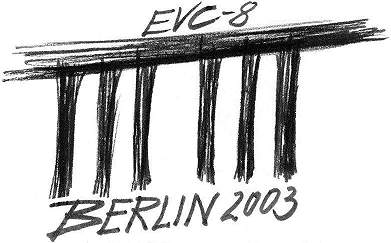 8th EUROPEAN VACUUM CONFERENCE (EVC-8)
8th EUROPEAN VACUUM CONFERENCE (EVC-8)
July 2003International Conference on Advanced Intelligent Mechatronics 2003).AIM2003 will be held in Kobe, JAPAN on July 20-24, 2003. We would be grateful if you are interested in the conference and consider to submit papers. We now provide a web-based electronic paper submission procedure so that you could submit papers easilly. Paper Submission
Tutorial/Workshop
Please find further information on our web site, http://www.aim2003.org/ For further inquiries and any questions, please feel free to contact us. We look forward to meeting you in Kobe next year ! Best Regards,
Shigeki Sugano, General Chair
Hideki Hashimoto, Program Chair
September 2003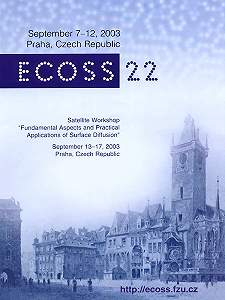 22th EUROPEAN CONFERENCE ON SURFACE SCIENCE (ECOSS-22)
22th EUROPEAN CONFERENCE ON SURFACE SCIENCE (ECOSS-22)
Fundamental and Practical Applications of Surface Diffusion Location and Time: Třešť castle, Czech republic, September 14 - 17, 2003
Scope of the Workshop:
The Conference will be concerned with results of theoretical and experimental investigations in the following general areas:
· Surface structure, morphology, roughness and topography
The International Workshop on Surface Physics is intended to replace the International Seminar on Surface Physics that was organized by the Institute of Experimental Physics of the University of Wroclaw in the years 1976 - 2000. During the last few years it has become clear that the original formula of the Seminar, which was intended as a platform for exchange of ideas between the scientist from the "East" and "West", is exhausted. The theme of the oncoming workshop will be: Metals on Solid Surfaces and will cover following topics:
· Surface topography
Up to date the following scientist have agreed to provide talks: The workshop is supposed to be a satellite meeting to the 22nd European Conference on Surface Science to be held in Prague, 7 - 12 September 2003. The format of the Workshop will be limited to about 100 - 120 participants. The venue of the Workshop will be Polanica Zdroj a small spa town located midway between Wroclaw and Prague (some 160 km from Prague), on the Polish side of the border. Organizers:
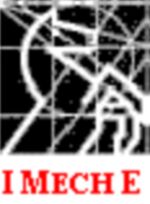 TRIBOLOGY IN ENVIRONMENTAL DESIGN 2003
TRIBOLOGY IN ENVIRONMENTAL DESIGN 20032nd International Conference
8th-10th September 2003 Sustainable Product Engineering of Bournemouth University Research Centre and the University of Oviedo in Spain at this conference will deal with the Characteristics of Interacting Surfaces; A Key Factor in Sustainable and Economic Products.
Objectives It is the purpose of this conference to draw together expertise in this multi-disciplinary field to assist in a better understanding of the issues relating to tribological characteristics so that they can be addressed early in the product design stage.
Conference Topics
Exhibition Facilities The first conference on Tribology in Environmental Design took place in 2001 and was a very great success, with a large international participation.
For general information please visit website:
For further information please contact
 Materials & Processes for Medical Devices Conference
Materials & Processes for Medical Devices Conference
Sponsored by: ASM International, The Materials Information Society Co-Sponsored by:
ASTM International Committee F04 on Medical and Surgical Materials and Devices This event will focus on materials, processes and technology as they relate to medical/dental devices:
Papers are solicited for, but not limited to, the following areas:
Please seriously consider your ability to prepare a full manuscript and present your work at the conference BEFORE submitting your abstract. All costs associated with your participation are your responsibility (travel, housing, registration, etc.) Interested authors should submit a 100-150 words abstract (in English) to www.asminternational.org/absubmit_meddevices.cfm; simply complete the requested presenter and co-author information: name, title, company/affiliation, complete address, phone and fax number and e-mail address. You will be notified as to the acceptance of your abstract approximately the first week of March 2003.
PUBLICATION:
Organizing Committee:
Visit the ASM website frequently at www.asminternational.org/meddevices for updates on this event.
Questions? Contact us: 

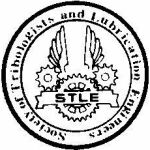 Smart Surfaces in Tribology: Advanced Additives and Structured Coatings
Smart Surfaces in Tribology: Advanced Additives and Structured CoatingsFirst Circular A European conference on recent developments in additive technology and surface coatings for the reduction of wear and friction on moving surfaces
Smart Surfaces in Tribology:
This meeting is organised jointly between the Brussels section of the Society of Tribologists and Lubrication Engineers (STLE, Brussels Section), the Swiss Federal Laboratories for Materials Testing and Research (EMPA) and Tribology Letters (Kluwer Publishing). It is aimed at people from industry and academic institutions, who have a shared interest in recent developments in elucidating the mechanisms of additives in forming protective coatings, as well as the increasing use, by coating manufacturers, of highly structured approaches to improving wear resistance.
Oral Presentation:
Poster Presentation:
Papers submitted for oral or poster presentations may be submitted for publication in a special edition of Tribology Letters, subject to normal reviewing procedures.
Prof. Hugh Spikes (Imperial College, England):
Dr Marcus Morstein (Platit AG, Switzerland):
Dr Sandrine Bec (Ecole Centrale de Lyon, France):
Dr Joerg Patscheider (EMPA, Switzerland):
10-12 September 2003
Hotel Renaissance, Zurich-Glattbrugg, Switzerland
Internet: www.empa.ch/sst
Dr Rowena Crockett, EMPA
STLE 2003 Annual Meeting and Exhibition ApriI 27-May 1, 2003, New York, NY STLE-ASME Joint Tribology Conference October 26-29, 2003, Jacksonyille, FL
To receive further information, please complete this form. Tick boxes as appropriate ? Please send the second circular and application form ? l would like to present an oral paper Closing date for submission of abstract: 28 February 2003 ? l would like to present a poster Closing date for submission of abstract: 31 March 2003 Provisional title for oral presentation or poster
Name Organisation Address Postcode Country Phone Fax
MECHTRIBOTRANS – 2003 The Russian academy of sciences in association with the Ministry of Transport of the Russian Federation, The Ministry of Transport Communication of the Russian Federation, Interdisciplinary Scientific Tribology Council, Association of Tribology Engineers and Rostov State University of Transport Communication have the honor to invite you to participate in the international Congress "Mechanics and Tribology of Transport Systems". The Congress will be held in September 10-13, 2003 in Rostov-on-Don (Russia). 15.08.2002 - first information message; 15.10.2002 - registration form and abstract; 15.12.2002 - confirmation of preliminary participation; 15.04.2003 - submission of papers and registration fee; 15.06.2003 - notification of acceptance and proceedings publishing. Authors are invited to send Registration forms and Abstracts to the Organizing Committee by 15.10.2002. Address: Myasnikova Nina Alekseevna
 INTERNATIONAL CONFERENCE ON EROSIVE AND ABRASIVE WEAR (ICEAW-II)
INTERNATIONAL CONFERENCE ON EROSIVE AND ABRASIVE WEAR (ICEAW-II)
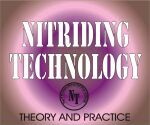 The 9th International Seminar IFHTSE NITRIDING TECHNOLOGY THEORY AND PRACTICE
The 9th International Seminar IFHTSE NITRIDING TECHNOLOGY THEORY AND PRACTICE
The Sponsor The Chairman of the Seminar PLACE OF THE SEMINAR DATE OBJECTIVE SCOPE OF TOPICS LANGUAGE OF THE DEBATES LECTURES THE SEMINAR MATERIALS THE SEMINAR WILL INCLUDE FRAMEWORK PROGRAMM 22.09.2003 23.09.2003 24.09.2003 25.09.2003 DETAILED PROGRAMME ACCOMMODATION APPLICATION FORM FAIR/EXHIBITION Director of the Institute of Precision Mechanics Chairman of the Seminar
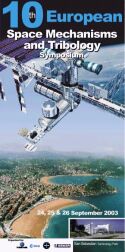 10th EUROPEAN SPACE MECHANISMS AND TRIBOLOGY SYMPOSIUM
10th EUROPEAN SPACE MECHANISMS AND TRIBOLOGY SYMPOSIUM
PRELIMINARY PROGRAMME The areas listed below are expected to be the major themes for the Symposium. Papers covering these areas are specifically encouraged, though all abstracts submitted will be given due consideration.
Mechanisms Design, Analysis and Hardware
Components/Equipment, Micro/Nano devices
Tribology and Materials
October 2003 10th EUROPEAN CONFERENCE ON APPLICATIONS OF SURFACE AND INTERFACE ANALYSIS (ECASIA'03)
10th EUROPEAN CONFERENCE ON APPLICATIONS OF SURFACE AND INTERFACE ANALYSIS (ECASIA'03)
 FIRST INTERNATIONAL MEETING on APPLIED PHYSICS (APHYS 2003)
FIRST INTERNATIONAL MEETING on APPLIED PHYSICS (APHYS 2003)
|